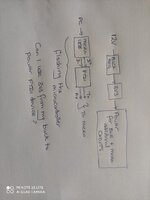Rajinder1268
Full Member level 3
Hi,
I have a microcontroller which is flashed via the PC through USB and FTDI. The FTDI is is powered internally (3V3).
I also need an external 3V3 LDO @600mA to power the rest of my circuitry i.e. BLE device etc.
Is there going to be any issue with me connecting the GND from USB to the main PCB GND?
Also is it ok to have the microcontroller programmed via FTDI 3V3 (it will only be flashed occasionally) and the rest of my circuitry from a 12V to 3V3 generated from a LDO or buck regulator. Are there any potential issues?
I have a microcontroller which is flashed via the PC through USB and FTDI. The FTDI is is powered internally (3V3).
I also need an external 3V3 LDO @600mA to power the rest of my circuitry i.e. BLE device etc.
Is there going to be any issue with me connecting the GND from USB to the main PCB GND?
Also is it ok to have the microcontroller programmed via FTDI 3V3 (it will only be flashed occasionally) and the rest of my circuitry from a 12V to 3V3 generated from a LDO or buck regulator. Are there any potential issues?
